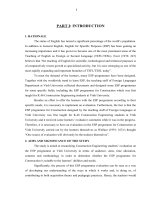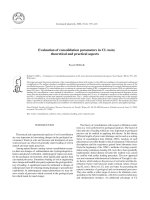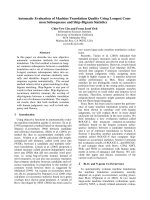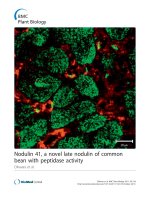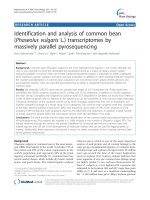Evaluation of common bean
Bạn đang xem bản rút gọn của tài liệu. Xem và tải ngay bản đầy đủ của tài liệu tại đây (174.52 KB, 8 trang )
SCIENTIFIC JOURNAL OF TAN TRAO UNIVERSITY
ĐÁNH GIÁ KHẢ NĂNG SINH TRƯỞNG VÀ NĂNG SUẤT CỦA MỘT SỐ DỊNG,
GIỐNG ĐẬU CƠ VE (Phaseolus Vulgaris L.) TRONG ĐIỀU KIỆN VÙNG SIBERIA
Nguyễn Nam Thành1*, Oksana V. Parkina 2, Olga E. Yakubenko 2, Denis A. Kolupaev 2,
Wang Z. Fen2
1
Viện Nông nghiệp và Tài nguyên, trường Đại học Vinh, Việt Nam
2
Novosibirsk State Agrarian University, Novosibirsk, Russia
Địa chỉ email:
...(Chỉ số do Tạp chí cấp)
THƠNG TIN BÀI BÁO
TĨM TẮT
Thí nghiệm đánh giá khả năng sinh trưởng và phát triển của 8
Ngày nhận
giống
đậu cô ve (Sunshine, Darina, F25 white black rub, F29 light
bài:
rub, F30 pink, Viola, F9 pink và F9 brown) trong vụ Xuân 2022
Ngày hoàn
tại Novosibirsk được bố trí theo khối ngẫu nhiên đủ (RCBD), 3
thiện:
lần lặp lại; giống Sunshine được sử dụng làm đối chứng. Kết quả
Ngày đăng:
cho thấy, trong 8 giống đậu tương thí nghiệm, 4 giống Darina,
TỪ KHÓA
F30 pink, F9 pink và F9 brown thuộc nhóm giống chín trung bình
Đậu cơ ve, giống, sinh sớm (thời gian sinh trưởng từ khi nảy mầm đến khi chín sinh học
là 76,5 - 80 ngày), các giống cịn lại thuộc nhóm giống chín trung
trưởng, năng suất, Siberia.
bình (thời gian sinh trưởng từ khi nảy mầm đến khi chín sinh học
là 80 - 90 ngày). Các giống đậu thí nghiệm có năng suất thực thu
dao động từ 1,22 - 3,73 kg/m2. Các giống Дарина và F30 pink có
các yếu tố cấu thành năng suất và năng suất đạt giá trị cao và sai
khác có ý nghĩa so với giống đối chứng và các giống còn lại.
*
tckh.daihoctantrao.edu.vn
1
Email:
SCIENTIFIC JOURNAL OF TAN TRAO UNIVERSITY
EVALUATION OF GROWTH AND YIELD OF SOME COMMON BEAN
VARIETIES UNDER SIBERIAN CONDITIONS
Nguyen N.T.1*, Parkina O.V. 1, Yakubenko O.E. 1, Kolupaev D.A.1, Wang Z.F.1
1
Novosibirsk state agrarian university, Russia
*
Email address:
…
ARTICLE INFO
ABSTRACT
The experiment to evaluate the growth and development
Received:
ability of 8 common bean varieties (Sunshine, Darina, F25 white
Revised:
black rub, F29 light rub, F30 pink, Viola, F9 brown, F9 pink) was
Published:
organized according to the scheme of randomized complete block
(RCBD), the variety Sunshine was used as a control. Field
KEYWORDS
experiment was conducted from the 3rd decade of May to the 1st
Common bean, variety, trait, decade of September in the experimental field of Novosibirsk
yield, Siberian.
state agrarian university "Michurintsev field". The results showed
that the experimental varieties of beans had a growth time from
sprouting to full maturity of 76.5 to 86.5 days. In 8 varieties, the
experimental bean varieties, 4 varieties Darina, F30 pink, F9 pink
and F9 brown belong to the group of medium early varieties
(growth time from seedlings to full maturity is 76.5 - 80 days), the
remaining varieties belong to the group of medium-maturing
varieties (growth time from seedlings to full maturity is 81 - 90
days). In the experimental bean varieties, the actual yield ranged
from 1.22 to 3.73 kg/m2. Varieties Darina and F30 pink had high
yield and yield components and differed significantly from the
control variety and others..
1. Introduction
Common bean (Phaseolus vulgaris L.) is the most important legume crop for direct human
consumption on a global scale. Modern bean germplasm collections show a wide variety of
phenotypes, although genetic erosion is gradually affecting this species as local traditional varieties are
replaced by elite varieties [1].
The specific benefits of vegetable beans lie in their composition, which includes essential vitamins
and micronutrients. Recently, the role of beans in the human diet has focused not only on their protein
content but also on their functional properties, and some authors have reported that their consumption
can help reduce the risk of obesity, diabetes, and cardiovascular disease [2].
Beans are part of a healthy diet and are becoming increasingly important due to increased
consumer interest in healthy foods. However, the volume of planting and production of vegetable
beans in Siberian does not yet correspond to the existing potential.
To increase the production of bean, it is necessary to intensify work on the selection of varieties
and the creation of new varieties that are promising, competitive and well adapted to the climatic
conditions of the region.
The study of economically valuable characters of samples plays an important role in breeding and
breeding varieties, which on the one hand depends on genetic properties of the breed, the proportion of
influence of genotype on the passage of phenological phases reaches more than 80% [3] and on the
other hand depends on land and climatic conditions. The aim of this study is to evaluate and select
*
tckh.daihoctantrao.edu.vn
2
Email:
SCIENTIFIC JOURNAL OF TAN TRAO UNIVERSITY
bean varieties with high yield potential and to select good varieties that contribute to higher
productivity and economic efficiency for producers.
2. Research methods
The experiment to assess the growth and development ability of 8 common bean varieties was
organized according to the scheme of randomized complete block (RCBD), Sunshine variety was used
as a control. Experimental plot area in the collection nursery was 2.1 m 2. Seeding rate of vegetable
beans was 22 pieces/m2.
Morphological description of plants was performed according to the Methodological guidelines for
the study of world bean collection specimens twice: during mass flowering and technical ripeness.
Bean weight is counted during the phase of technical ripeness, plucking all the formed beans from
10 fixed plants. Collecting is carried out 3 times from the beginning of ripening every 7 days. The
number of beans is counted and their weight is counted.
Mathematical data processing was performed using IRRISTAT software according to the method
of analysis of variance [4].
3. Research results and discussion
3.1. Climate change in Novosibirsk during the experiment in 2022
During the experimental period in 2022, the average daily temperature ranged from 7 – 23 ⁰C,C,
which is quite low compared with the optimal temperature for growth and development of bean plants.
According to studies by some authors, a minimum soil temperature of 12°C is necessary for seed
germination, while the optimum temperature is 22-30°C [5]. The optimum temperature during
budding and flowering is 20-25 ⁰C,C, for full vegetation - 20-25⁰C,C [6].
Sowing was carried out on 23 May, but 1 week after sowing rather dry weather was established,
average daily temperature ranged from 12-15 ⁰C,C, air humidity varied from 58 to 63% and average
rainfall was very low - 1,68 mm/day. During the first 10 days of June weather became quite cold
(average daily temperature was 12°C, especially at night, while temperatures dropped to 4°C). Low
temperature and low precipitation at this stage have a great impact on germination of seeds, as well as
on the development of the bean plant in the early period.
Thus, in the first 3 weeks after sowing, the weather changed erratically, but in the second decade of
June weather conditions improved and the bean plants developed more actively.
In June, July and August the total amount of precipitation for the month is 53 mm, 69 mm and 59
mm, respectively, but precipitation is unevenly distributed by day of the month. There are times of
heavy rain, concentrated heavy rain on some days, so flooding is localized, the soil is polluted and
strongly affects the growth and development of plants during flowering and fruit formation.
Overall, agroclimatic conditions during the 2022 field experiment were heterogeneous for legume
plant growth and development during the growing season and reduced yield factors and yield
composition of experimental bean varieties.
tckh.daihoctantrao.edu.vn
3
Email:
SCIENTIFIC JOURNAL OF TAN TRAO UNIVERSITY
80
70
60
Daily average
temperature
(⁰C)
Average humidity (%)
Total rainfall
(mm/month)
50
40
30
20
10
0
May
June
July
August
Figure 1. Dynamics of some meteorological factors by months in 2022
3.2. Morphological characteristics of experimental varieties
The results of the study of morphological characteristics of experimental bean varieties presented
in Table 2 show that all bean varieties have purple or green stem color, dark green or purple leaves.
Flower color of varieties Darina, Viola, and F9 brown with light white pink, violet, and light white
purple, respectively, while the other varieties have white flowers mixed with yellow, respectively.
Fruit color in Sunshine and Viola varieties was yellow and purple, respectively, while the other
varieties were green. The fruits of all varieties were straight and fiberless.
The seed color of Darina, Viola, and F9 brown varieties were beige, cream, and brown,
respectively, while F30 pink and F9 pink varieties had dark pink seed color, and the other varieties had
white seeds.
Table 1. Morphological characteristics of experimental varieties
Pattern
Sunshine
(control)
Darina
F25 white
black rub
F29 light rub
F30 pink
Viola
F9 pink
F9 brown
Stem colour
Leaf colour
Flower colour
Fruit colour
Grain colour
green
dark green
white and yellow
yellow
white
green
dark green
light white pink
green
beige
green
dark green
white and yellow
green
white
green
green
violet
green
green
dark green
dark green
violet
dark green
dark green
white and yellow
white and yellow
violet
white and yellow
light white purple
green
green
violet
green
green
white
dark pink
creme
dark pink
brown
3.3 Stages of growth and development of experimental bean varieties
The experimental results shown in Table 2 show that with the exception of varieties F30 pink and
F9 brown with germination rates of 56% and 72%, respectively, the remaining varieties had relatively
high germination rates ranging from 81 to 98%. According to Akulov A.S. (2010), suitable soil
moisture for bean germination is usually 65-70% and the most suitable temperature is 18-22 ⁰C,C [7].
Sowing in late May, when rainfall and temperature are relatively low (precipitation 1.68 mm/day and
average daily temperature 15⁰C,C), which slows germination of common bean seeds. This cold and dry
tckh.daihoctantrao.edu.vn
4
Email:
SCIENTIFIC JOURNAL OF TAN TRAO UNIVERSITY
condition lengthened the time from sowing to germination and also lengthened the growth period at
the seedling stage.
The time from cultivation to flowering ranged from 26.5 to 36 days, in which the variety Viola had
the longest time from cultivation to flowering at 36 days, followed by the variety Sunshine at 34.5
days. The time from flowering to ripening is 8 to 15 days. Growth time (from germination to technical
ripeness) ranged from 36.5 to 44 days, of which Darina and F30 pink varieties had the shortest growth
period (36.5 days); Sunshine, Viola and F9 pink varieties had the longest growth period (44 days).
Table 2. Growth and development stages of experimental varieties
№
1
2
3
4
5
6
7
8
Pattern
Sunshine (control)
Darina
F25 white black rub
F29 light rub
F30 pink
Viola
F9 pink
F9 brown
CV (%)
LSD 0,05
Germinatio
n (%)
81b
93c
88c
81b
56a
96c
98c
72b
7.4
14.56
Time from
sprouting to
flowering
(days)
34.5d
28.5b
31c
27.5a
26.5a
36e
29b
28.5b
2.0
1.39
Time from
flowering to
ripening
(days)
9.5a
8a
8a
11b
10a
8a
15c
14.5c
8.8
2.18
Growth time
(days)
44b
36.5a
39a
38.5a
36.5a
44b
44b
43b
2.8
2.67
Note: Different small leters in the table meant a significant difference among treatments at 0.05 level
3.4. Growth and development characteristics of the experimental bean varieties
The results of the evaluation of growth and development characteristics of the experimental bean
varieties presented in Table 3 show that: "Plant height" (length of the main stem) depends on the
genotype of the variety, as well as on growing conditions [8]. In our study, the height of plants in
varieties varies from 24,55 to 41,75 cm. Viola variety has the highest tree height (41,75 cm), the line
Sunny has the lowest value (24,55 cm).
The height of the lowest attached fruit is one of the important criteria in the selection of beans with
the use of mechanized harvesting. If the height of the fruit pack is too low compared to the machine's
requirements, the machine will not be able to harvest the entire crop, resulting in losses and reduced
productivity. Conversely, too high a fruiting height results in limiting the yield potential of the variety.
Therefore, the height of the lowest attaching fruit is an indicator that negatively correlates with plant
yield.
The height of the lowest attached fruit ≥ 10 cm is appropriate for current harvesters. The results of
fruit height monitoring of the varieties showed that the height of fruiting varied from 9.2 to 13.02 cm,
except for the variety Darina, whose fruit height (13.02 cm) was significantly higher compared to the
control variety (10.85 cm) at 95% probability level; other varieties had significantly lower height of
fruiting compared to the control variety.
Table 3. Some growth parameters of experimental bean varieties
tckh.daihoctantrao.edu.vn
5
Email:
SCIENTIFIC JOURNAL OF TAN TRAO UNIVERSITY
№
1
2
3
4
5
6
7
8
Pattern
Sunshine (control)
Darina
F25 white black rub
F29 light rub
F30 pink
Viola
F9 pink
F9 brown
CV (%)
LSD 0,05
Height of
plant (cm)
Height of lowest
attached fruit
(cm)
Fruit length
(cm)
Fruit width
(cm)
24.55a
30.55b
27.68a
30.47b
28.23a
41.75c
26.47a
31.6b
5.1
5.47
10.85a
13.02b
10.77a
10.43a
10.27a
9.2a
10.52a
10.77a
5.8
2.21
11.41b
7.13a
12.7c
12.83c
6.88a
13.29d
12.75c
14.36e
2.1
0.33
0.86a
0.98a
0.9a
0.93a
0.86a
0.85a
0.88a
0.79a
2.4
0.25
Note: Different small leters in the table meant a significant difference among treatments at 0.05 level
"Fruit length" is a characteristic trait that determines marketability and canning suitability, since
beans are canned both whole beans and sliced beans. For low waste, it is important that the beans be
straight, not strongly bent at their ends, or perfectly straight. Fruit length in our study ranged from 6.88
to 14.36 cm (CV=2,1%). The varieties studied were formed into groups: short bean (5.1-10.0 cm) - 2
samples, medium length (10.1-14.0 cm) - 5 samples and long (>14.0 cm) - 1 sample. In the selection
of vegetable beans for industrial production of green beans, parameters characterizing the asparagus
bean, such as absence of parchment and fiber in the bean, dark green coloration of the bean, taste
qualities of the bean, losses when preparing beans for freezing in industrial production (low waste),
bean length, width and thickness are also important. All these traits and parameters must be taken into
account by the breeder when creating varieties that meet the requirements of the market and the
processing industry.
3.5. Yield components of experimental bean varieties
The results of evaluation of yield components of experimental bean varieties, presented in Table 4,
show that: The total number of fruits/plant of the varieties ranged from 9.95 to 25.8 fruits, , in which
there are 5 bean varieties with lower total number of fruits/plant than the control variety: F25 white
black rub, F29 light rub, Viola, F9 pink and F9 brown. Varieties Darina and F30 pink had significantly
higher total number of fruits/plant than the control at 95% probability level.
Weight of 100 fruits in bean varieties ranged from 379.73 to 657.75 g, with the control variety
Sunshine having the lowest weight of 100 fruits (379.73 g), all other varieties had higher weight of
100 fruits, significance compared to the control variety at the 95% probability level.
Table 4. Some components of yield of experimental bean varieties
№
1
2
3
4
5
Pattern
Sunshine (control)
Darina
F25 white black rub
F29 light rub
F30 pink
tckh.daihoctantrao.edu.vn
Number of
beans/plant
(bean)
Weight of
100 beans
(g)
Individual
yield (g/plant)
Actual yield
(kg/m2)
19.65d
25.8e
14.9c
13.55b
23.75e
379.73a
657.75f
562.35c
636.97e
477.89b
74.62b
169.7d
83.79b
86.31b
113.5c
1.64b
3.73d
1.84b
1.9b
2.5c
6
Email:
SCIENTIFIC JOURNAL OF TAN TRAO UNIVERSITY
6
7
8
Viola
F9 pink
F9 brown
CV (%)
LSD 0,05
14.05b
12.45b
9.95a
13
2.32
576.48d
480.36b
556.43c
2.8
18.35
81b
59.81a
55.37a
15
14.13
1.78b
1.32a
1.22a
15
0.31
Note: Different small leters in the table meant a significant difference among treatments at 0.05 level
Yield is an important criterion in evaluating the performance of the experimental bean varieties.
The results presented in Table 4 show that the individual yields of the varieties range from 55.37 to
169.7 g/plant, the highest in the variety Darina and the lowest in the variety F9 brown.
Actual varietal yields ranged from 1.22 to 3.73 kg/m2, with actual yields of F9 brown and F9 pink
varieties being significantly lower than those of controls at 95% probability. The other varieties had
significantly higher net yields than controls (1.64 kg/m2) at 95% probability, ranging from 1.78 to
3.73 t/ha.
3.6. Correlation between growth stages and individual productivity
In this study, the time from germination to flowering was longer than the time from flowering to
fruit ripening. Accordingly, the growth times of the varieties ranged from 36 to 44 days. There was a
significant positive correlation between time from germination to flowering and total growth time with
a correlation coefficient of 0.65, but a negative correlation with time from flowering to ripening with a
correlation coefficient of -0.42 (Table 5).
Meanwhile, the correlation between individual productivity and time from growing to flowering;
with time from flowering to ripening; with total growth time -0.28, - 0.6 and - 0.77 respectively. Thus,
individual productivity is negatively correlated with length of growing season, meaning that varieties
with a shorter growing season have higher individual productivity and vice versa. This explains why
the variety Darina with the shortest growing season (36.5 days) gives the highest individual yield
(169.7 g/plant).
Table 5. Correlation coefficients between growing periods and individual productivity of
experimental bean varieties
SF
FR
GR
IP
SF
1
- 0.42
0.65
- 0.28
FR
GR
IP
1
0.42
- 0.60
1
- 0.77
1
Note: SF: time from sprouting to flowering; FR: time from flowering to ripening; GR: growth
time; IP: individual productivity
4. Conclusions
Experimental bean varieties had growth time from seedlings to full maturity of 76.5 to 86.5 days,
of which 4 varieties Darina, F30 pink, F9 pink and F9 brown belong to the group of medium early
varieties (growth time from seedlings to full maturity of 76.5 - 80 days), the remaining varieties
belong to the group of medium-maturing varieties (growth time from seedlings to full maturity of over
80 days). The height of plants varieties ranges from 24.55 to 41.75 cm.
Varieties Darina, F25 white black rube, F29 light rub and F30 pink have high values of the
parameters of growth, yield and yield components and differ significantly from the control variety and
the rest. Among them, variety Darina had the highest weight of 100 fruits (657.75 g), followed by the
variety F29 light rub (636.97 g). Variety Darina had the highest individual yield (169.7 g/plant) and
tckh.daihoctantrao.edu.vn
7
Email:
SCIENTIFIC JOURNAL OF TAN TRAO UNIVERSITY
net yield (3.73 kg/m2) compared to the experimental varieties. F30 pink variety had the second highest
net yield (2.5 kg/m2) and was significantly higher than the other varieties.
To improve the effectiveness of crossing in Siberia in this study, the following varieties are
recommended as a source of economically valuable traits: Darina, F30 variety, F29 light rub and F25
white black rub.
Refferences
[1] Antonio, M.D., Ana M.G., Paula A.R. (2016). History of the common bean crop: its evolution
beyond its areas of origin and domestication. Grain legumes in future agriculture. Mayo - junio a317:
192-202.
[2] Thompson, M.D., Brick, M.A., McGinley, J.N. (2009). Chemical composition and mammary
cancer inhibitory activity of dry bean. Crop Science, 49: 179-180.
[3] Parkina O.V., Yakubenko O.E. (2017). The duration of the phenophase of common beans,
depending on hydrothermal conditions. Michurinskii agronomicheskii vestnik. Michurinsk (Russia):
Agropishcheprom:117-122.
[4] Pham Tien Dung (2008). Experimental design and results processing using IRRISTAT
statistical software. Hanoi University of Agriculture, Hanoi.
[5] Wortmann, C.S. (2006). Phaseolus vulgaris L. (common bean). PROTA (Plant Resources of
Tropical Africa, Wageningen, Netherlands.
[6] Lukyanets, V.N., Bobrova, R.A., Fedorenko, E.V., (2005). Leguminous plants. Aleuron,
Kazakhstan.
[7] Akulov A.S., Borzyonkova G.A., Vasilchikov G.A., Golopyatov M.T., Zotikov V.I.,
Miroshnikova M.P., Naumkina T.S., Khlebnikov A.I. (2010). Perspective resource-saving technology
of bean production. FGNU "Rosinfartagrotech", Pravdinskiy, Moscow Region.
[8] Anton Sh., Smirnova A.M., Antoshkin A.A. (2018). Evaluation of vegetable bean collection
specimens according to economically valuable features in the conditions of the Moscow region.
Vegetables of Russia. 2018;(5), p. 43-46.
tckh.daihoctantrao.edu.vn
8
Email:


